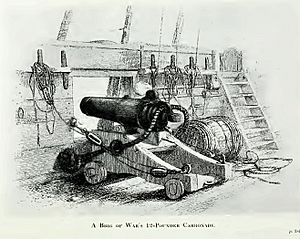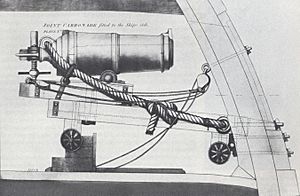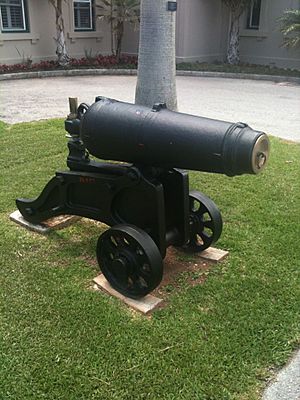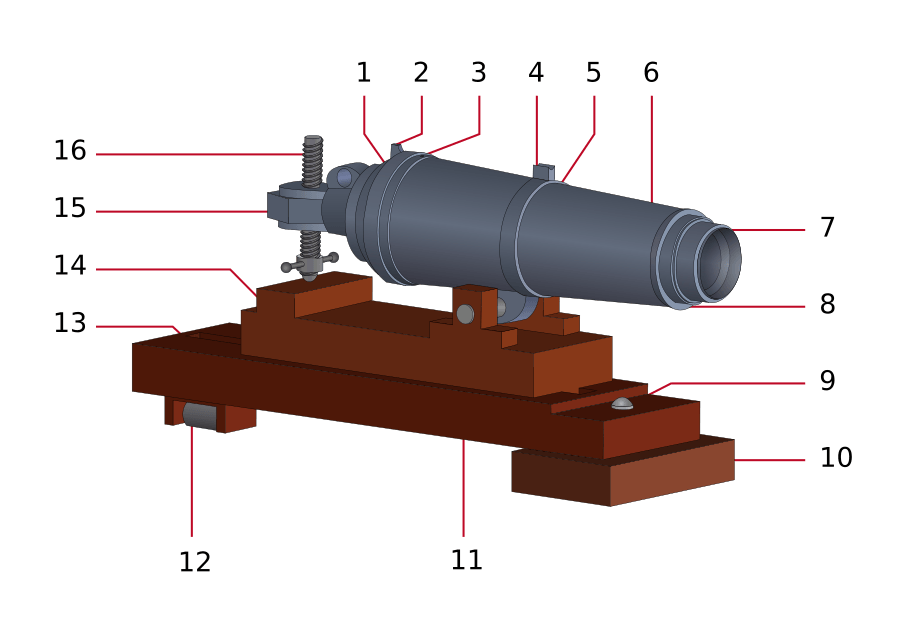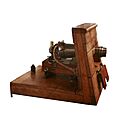Carronade facts for kids
A carronade was a special type of cannon used by the Royal Navy (the British navy). It was short, had a smooth barrel, and was made of cast iron. This powerful weapon was first made by the Carron Company in Falkirk, Scotland. It was used from the 1770s to the 1850s.
The main job of a carronade was to be a strong weapon for short distances. It was great for attacking enemy ships and their crews. What made it special was how precisely it was made. The cannonball fit much more tightly inside the barrel. This meant more of the gunpowder's energy pushed the cannonball, making the gun lighter and needing less gunpowder to be effective.
Carronades were very successful at first. But they slowly disappeared as naval weapons got better. New technologies like rifling (grooves inside the barrel) and exploding shells replaced solid cannonballs. Also, naval battles started happening over longer distances, which carronades weren't designed for.
Contents
History of the Carronade
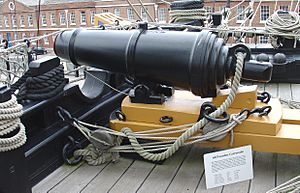
The carronade was first designed for merchant ships. These were trading ships that needed a weapon for close-range defense. It had a low muzzle velocity, meaning the cannonball didn't shoot out super fast. But it also became useful for warships.
The Carron Company made these weapons. They sold them as a complete package: the gun, its mount, and the cannonballs. A typical package included different types of shot like roundshot, barshot, and grapeshot.
People aren't sure who invented the carronade. Some say it was Robert Melvill in 1759, while others credit Charles Gascoigne, who managed the Carron Company from 1769 to 1779. In its early days, it was sometimes called a "mellvinade" or a "gasconade." The carronade was part of a trend to make naval guns shorter and use less gunpowder.
Why was the Carronade designed this way?
An advertisement from 1779 explained the benefits for merchant ships. Since the same company made both the cannon and the cannonballs, they could make them fit together much better. This reduced the "windage," which was the gap between the cannonball and the barrel.
Using less gunpowder meant the barrel didn't get as hot during a fight. It also reduced the gun's kickback, called "recoil." The carronade's special mount was attached to the ship's side on a pivot. This mount absorbed the recoil without moving the gun out of aim.
The carronade was also designed to be easier for merchant sailors to use. These sailors weren't as highly trained as navy gunners. It was simpler to aim and reload. Instead of trunnions (side pins), it had a bolt underneath to connect to the mount. This made the carriage narrower, allowing the gun to turn and fire over a wider area. This wide firing angle was very important for merchant ships, which often needed to shoot at enemies while trying to escape.
A carronade weighed only a quarter as much as a "long gun" that fired the same size cannonball. It also used only a quarter to a third of the gunpowder. This meant ships could carry more carronades or bigger ones. Lighter carronades could be placed on upper decks without making the ship top-heavy and unstable. They also needed fewer crew members, which was a big plus for merchant ships, and they were faster to reload.
How was the Carronade first used?
Carronades became popular on British merchant ships during the American Revolutionary War. A light gun that needed few crew members and was powerful at short range was perfect for defending against French and American privateers (private ships allowed to attack enemy shipping).
The French first got carronades in 1779 but didn't think they were effective at the time. However, in a battle on September 4, 1782, a single carronade shot from HMS Rainbow at close range made a French captain surrender.
The Royal Navy was slow to adopt carronades at first. They didn't trust the Carron Company. Carronades weren't even counted when ships listed their number of guns. But Lord Sandwich started putting them on the front and back decks of warships. They quickly proved how effective they were in battle.
French gun makers couldn't make similar weapons for 20 years. This gave British warships a big advantage in the late 1700s. HMS Victory, a famous British warship, used two 68-pounder carronades at the Battle of Trafalgar. They fired a cannonball and a keg of 500 musket balls through an enemy ship's stern windows, clearing its gun deck.
Carronades were very successful and widely used. Some ships, like HMS Glatton and HMS Rainbow, even had only carronades. Glatton, a ship with 56 guns, could fire a more powerful shot at short range than HMS Victory, which had 100 guns! Both Glatton and Rainbow did well in battles. However, the carronade's short range was a problem if an enemy ship stayed far away.
In the 1810s and 1820s, naval tactics changed. People started focusing more on accurate long-range shooting. Carronades began to disappear from the Royal Navy around the 1850s. This was because better cannons were developed by people like William George Armstrong and Joseph Whitworth. However, carronades were still used in the American Civil War in the 1860s. The last known use of a carronade was in the First Boer War, where the Boers used an old carronade called 'Ou Griet' against a British fort.
How Carronades were Designed

The first carronades had a special wooden carriage. The cannon had a loop underneath that was pinned to the carriage. This allowed the gun to turn. The recoil was handled by a sliding mount. To raise or lower the gun, early versions used a wedge, while later ones used a screw.
Carronades had a smaller chamber for the gunpowder than the main barrel. For example, an 18-pounder carronade had a chamber the size of a 12-pounder. This made the cannon lighter but also reduced the speed of the cannonball and its range. However, carronades had a much tighter fit between the cannonball and the barrel (less "windage"). This meant more of the gunpowder's force pushed the ball, making up for some of the lost power.
Naval cannons during the Age of Sail were not very accurate. Most barrels were smooth, not rifled, and there were many small differences in how they were made. Sights were very basic or didn't exist. Aiming was often done by guesswork. Because of this, important naval battles usually happened at very close ranges, often less than 100 yards. At these distances, the carronade's heavier cannonball was very useful, and its shorter range wasn't a big problem.
Even with improvements in the 1800s, muzzle-loading smoothbore cannons were still not very accurate. So, naval tactics relied on firing many shots quickly at close range, where carronades were very effective. On smaller ships like frigates or privateers, captains still liked long guns for their greater range. These ships often needed to chase or escape, and it was better to try and damage an enemy's rigging from a distance rather than get into a close fight where their weaker hulls were at risk.
Different Sizes of Carronades
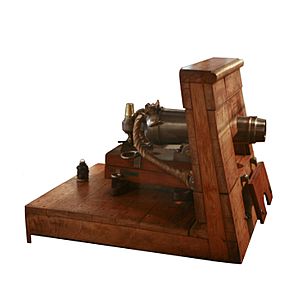
A carronade was much shorter and weighed only a third to a quarter of a similar "long gun." For example, a 32-pounder carronade weighed less than a ton, but a 32-pounder long gun weighed over 3 tons! Carronades were made in common naval gun sizes: 6-, 12-, 18-, 24-, 32-, 42-, and 68-pounder versions.
Smaller carronades had a few uses:
- They were sometimes the only weapons on smaller ships. For example, some schooners (a type of sailing ship) only had four 12-pounder carronades.
- Gunboats often had one large carronade (18-, 24-, or 32-pounder) at the front on a pivot, and two smaller ones at the back.
- Larger ships carried a few 12-, 18-, or 24-pounders to arm their smaller boats (like cutters or launches). This gave these boats firepower for small battles.
Even very small ships might carry the huge 68-pounder carronades. For instance, Commander William Layman of HMS Raven replaced some of his ship's guns with two 68-pounders. This greatly increased his ship's firepower.
Carronades were not counted in a ship's official "number of guns." So, a Royal Navy ship might be listed with fewer guns than it actually carried, because the carronades weren't included in the count.
Unlike other naval guns, carronades were usually mounted on a sliding carriage instead of one with wheels. To change the elevation (how high or low it aimed), a screw was used, similar to field guns, instead of wooden wedges. Also, a carronade was usually mounted from a lug (a projection) underneath the barrel, not from pins on the sides (trunnions). This gave it a higher center of gravity. Later, some carronades were made with trunnions to lower their center of gravity; these were called "gunnades."
In the late 1700s, a new type of cannon called a "cannonade" was developed. It was a mix between a long gun and a carronade. For example, the "medium 18 pounder" was shorter and lighter than a long gun but longer than a carronade. In theory, it sounded good, but it was less accurate and had a shorter range than a long cannon. It was also less powerful than a carronade. Because it was too light for its powerful charge, it often had too much recoil and broke its ropes. These "cannonades" were quickly removed from service, though some were kept on merchant ships like those of the East India Company.
The East India Company (EIC) also used carronades, and theirs were often larger and heavier than those used by the Royal Navy. For example, an EIC 18-pounder carronade was 5 feet long and weighed 15.5 hundredweight (cwt), while the Royal Navy's 18-pounder was 3 feet 3 inches long and weighed 10.5 cwt.
Range of Carronades
Normally, there was a noticeable gap (called windage) between the cannonball and the inside of the gun barrel. This was because cannonballs weren't perfectly round, and barrels weren't perfectly bored. This gap could be as much as a quarter of an inch and caused a lot of power to be lost. The Carron Company's manufacturing methods greatly reduced this windage.
Even with less windage, carronades had a much shorter range than long guns. They typically shot only a third to half the distance. This was because they used a much smaller amount of gunpowder. However, naval tactics in the late 1700s focused on short-range battles, so the limited range wasn't seen as a big problem.
At sea, the long range of a long gun wasn't always useful. Ships were moving platforms, making it very hard to time shots perfectly. The ship's rocking (pitch and roll) meant most battles happened at close range, usually a few hundred yards or less.
In battles between warships, carronades could be a disadvantage if the fight happened outside their close-range effectiveness. For example, the USS Essex, a frigate armed almost entirely with carronades, was badly damaged by the longer-range guns of HMS Phoebe and HMS Cherub in the Battle of Valparaíso in 1814.
Warships often aimed at the enemy's hull to destroy the ship. A cannonball fired from a ship on a downward roll could even bounce off the water into the enemy hull. Merchant ships, however, often aimed at the larger target of the masts and rigging. This was in hopes of damaging the enemy's sails and escaping. The higher path needed for carronades at longer ranges (400 yards or more) wasn't a big problem for merchant ships or any ship trying to escape a stronger enemy.
For centuries, people thought longer barrels meant longer range. But experience showed that making barrels shorter didn't reduce performance as much as expected.
Carronade Diagram
Images for kids
-
68-pounder British naval carronade, with slider carriage, on HMS Victory
-
Admiralty carriage mount for an 18-pounder carronade, 1808
-
Model of a carronade with grapeshot ammunition
See also
 In Spanish: Carronada para niños
In Spanish: Carronada para niños


